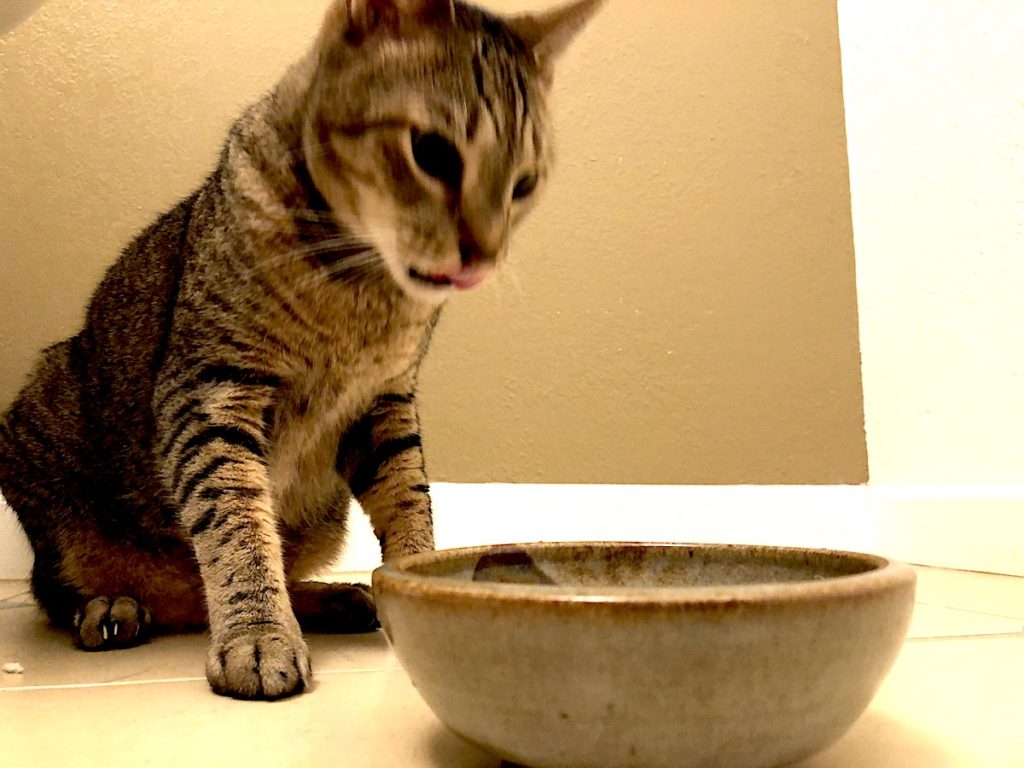In this article, Ginger shares the results of her research on feeding cats
Dear human,
Cats’ taste buds are just as advanced as humans, and so the flavor, texture, odor, and temperature of food are important to us. However, it’s come to my attention that many of you lack important information about keeping cats properly fed. Therefore, below I summarize eight basic facts, along with rules for feeding us cats. I bet you will learn something new!
RULE #1. FEED US MEAT!
Unlike humans and dogs, who are omnivores, we cats are true carnivores. Cats need meat to stay healthy. In fact, dear human, we cannot properly digest vegetables, even plant proteins like soybean meal and Brewer’s yeast [1,2]. Unlike humans and dogs, we do not use carbohydrates as our primary source of energy. And when we eat grass, we do so to help us vomit up hairballs [1,2]. Feed us meat!
Below, I will show you how to make sure that your cat’s food contains healthy meat. Raw meat is also an option, but you humans better know how to choose meat that is sanitary and handle it so that it does not become contaminated by bacteria. Otherwise, cats (and their humans) could get toxoplasmosis or other deadly diseases [1,3]. If you’d like to feed your cat raw food, talk to your veterinarian to make sure your cat’s raw diet includes the nutrients we need.
RULE #2. REMEMBER THESE FUNNY TERMS.
Meat “by-products” include organ meat such as liver and are considerred a good source of nutrients for cats [1,4].
“Meal” is the term for animal carcass material that has been ground and had the water removed. Poultry meal, for example, is dried chicken carcasses (minus the feathers, feet, and beaks) [1,4].
RULE #3. KNOW THE BASICS.
Commercial cat foods come as dry, semi-moist, and canned. All three types can be healthy, depending on the quality of the food (see Rule #4).
- Dry cat food is relatively inexpensive. Dry kibble often consists of “meal” coated with flavor enhancers, such as animal fat, so they taste pretty good. Depending on the type and quality of the ingredients, dry food can be less digestible than wet food [2,4]. Keep dry food in a cool, dry location, and please, dear human, throw expired food out.
- Semi-moist food generally costs less than canned food and contains meat and meat byproducts. Some semi-moist food contains other materials that are not so good for us cats, like soybean meal, cereals, grain byproducts, and preservatives. Another disadvantage of semi-moist food is that it cannot be stored long once opened [2,4].
- Canned cat food is generally the most expensive cat food, but most of us love it. Better quality canned cat food contains real meat and whole meat byproducts. Lower-quality brands, however, can be nutritionally incomplete. Read the nutrition labels (see below). Another advantage of canned food is that, like meat, it can be stored in the refrigerator once opened [2,4]. And, like I said, we love it.!
RULE #4. LEARN HOW TO IDENTIFY QUALITY CAT FOOD.
Most vets recommend you give us high-quality commercial cat food and avoid human food, including canned tuna. Some human foods are toxic to cats. Canned tuna and related fish products meant for humans can cause neurological problems in cats [2,4].
Here’s how to know if a commercial cat food will provides enough meat and the amino acids and vitamins we need [2,4].
- Read the pet food package or website to learn about the food’s nutrition. Look for an AAFCO-approved nutritional guarantee which lets you know that the food is nutritionally complete. If the label states that the food meets the requirements of the AAFCO for a particular stage of a cat’s life cycle (e.g., kittenhood, adulthood, lactation, old age, etc.), the food is complete and balanced only for that stage. Some cat foods are formulated for all life stages, which is helpful for humans who serve multiple cats of different ages.
- Read the ingredients list. The ingredients are listed from highest proportional weight to lowest. Choose food in which meat, meat byproducts, or seafood are the first few ingredients.
Still not sure? Your vet can help you choose the best food for your cat.
RULE #5. MAKE IT FUN.
Cat food trees and food puzzles make us work for our food and keep us from eating too quickly. As a formerly starving feral cat, I can’t help but eat too fast, which causes me to throw up my food. Therefore, my humans use a food tree. It’s a fun game for me to find the food.
After my meal, I get to go on an “Easter egg hunt” and search for more hidden treats on my tree (see video). Some of us also like rolling food toys that drop out kibble when we push it. I worked for my food when I was a feral cat, so it feels good to do that inside, too.
RULE #6. SLIGHTLY WARM IS GOOD.
Unlike humans, we cats prefer food with a strong odor. Warm food has a delightful aroma, and we cats prefer slightly warm meals over cold food. When we are sick; warming up our food (only slightly – don’t burn us!) can help stoke our appetites [2].
RULE #7. TREAT TREATS LIKE COOKIES.
Think of cat treats like cookies. An occasional treat is fine, but treats are not nutritionally complete and should never replace food. Treats should make up no more than ten percent of our daily caloric intake [1].
RULE #8. KEEP IT REGULAR.
Cats like a regular routine. Feeding us at regular times helps us feel secure. Also, you may notice that we are pretty lazy as well. Indoor cats should be fed small meals rather than keeping our bowls filled for all-day grazing. Use a measuring cup or spoon to get the correct amount each time [2].
Kittens must be fed at least five times a day. After eight months, adult cats must be fed at least twice a day. Never let more than 12 hours elapse between adult cat meals. Otherwise, our bellies can become too acidic, which causes nausea [2]. My humans feed us four small meals every day.
So, there you have eight important rules, recommended by most veterinarians. Of course, expert opinions do vary. Go with what you think is best. We cats will love you for it. And don’t forget, we cats need access to clean, fresh water at all times. Now, when’s feeding time!?





Helpful article. Thank you!
thanks for this very informative message on cat foods and the rules thank you hugs x o
I appreciate this information, especially the definitions. Great job, Ginger!
I learned a lot. Thank you!
Very informative article. There was some information here I wasn’t aware of before. Thanks Ginger.